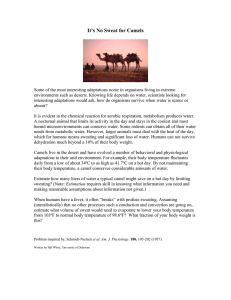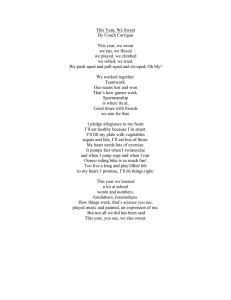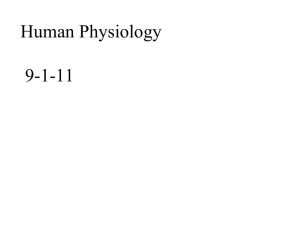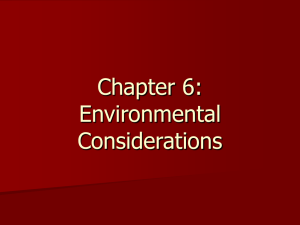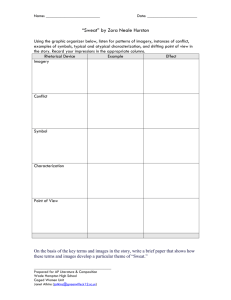TABLE OF CONTENT CHAPTER TITLE PAGE
advertisement
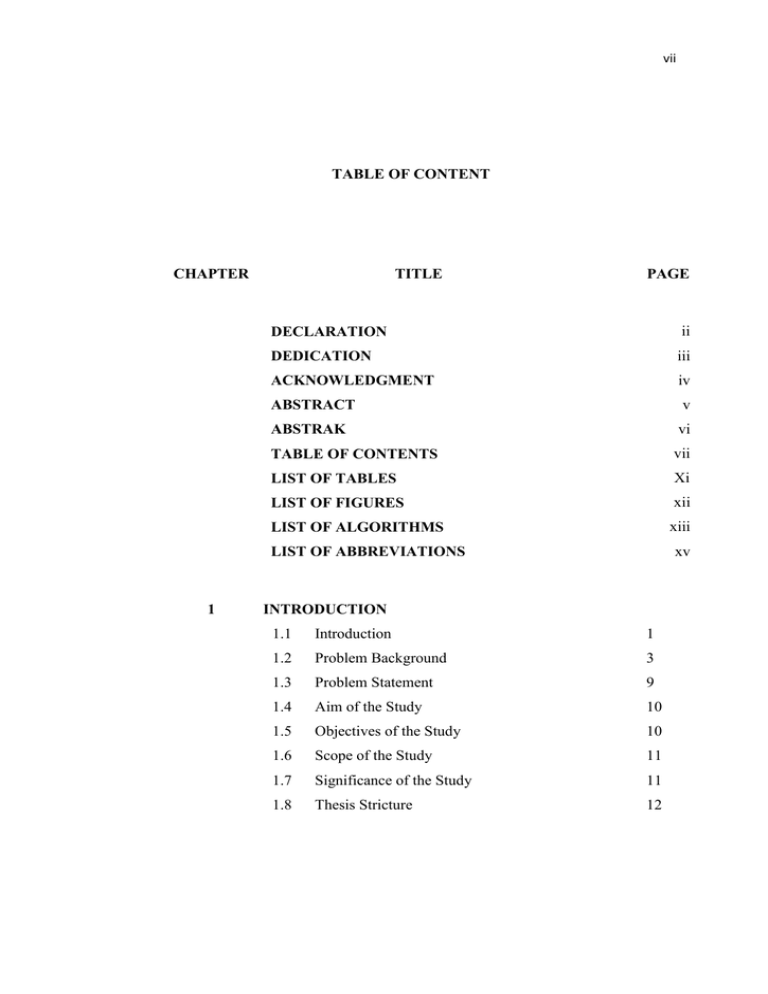
vii TABLE OF CONTENT CHAPTER TITLE PAGE DECLARATION ii DEDICATION iii ACKNOWLEDGMENT iv ABSTRACT v ABSTRAK vi TABLE OF CONTENTS vii LIST OF TABLES Xi LIST OF FIGURES xii LIST OF ALGORITHMS xiii xv LIST OF ABBREVIATIONS 1 INTRODUCTION 1.1 Introduction 1 1.2 Problem Background 3 1.3 Problem Statement 9 1.4 Aim of the Study 10 1.5 Objectives of the Study 10 1.6 Scope of the Study 11 1.7 Significance of the Study 11 1.8 Thesis Stricture 12 viii 2 LITERATURE REVIEW 2.1 Introduction 14 2.2 Facial Animation 15 2.2.1 Traditional Polygonal Mesh 16 2.2.2 Splines Based Models 17 2.2.3 Pose Animation 18 2.2.4 Facial Action Coding System 19 2.3 2.4 2.5 3 Emotion Expression 20 2.3.1 Facial Gesture Generation 21 2.3.2 Extreme Expression 24 Sweat simulation 24 2.4.1 Fluid simulation 25 2.4.2 Texture based simulation 27 Discussions 29 RESEARCH METHODOLOGY 3.1 Introduction 30 3.2 Research Methodology 31 3.3 Facial Animation 33 3.3.1 3.3.2 3.4 Facial Action Coding System (FACs) 33 Action Units (AU) 35 Facial features of Extreme Expression 36 3.4.1 Fluid Generator 37 3.4.1.1 Simple particle system 37 3.4.1.2 Particle-Particle Interactions 38 3.4.1.3 Navier-Stokes Equations for Incompressible Flow 38 Texture Based 41 3.4.2 ix 4 3.5 Extreme Expression Generator 41 3.6 Testing and Evaluation 42 3.7 Summary 42 IMPLEMENTATION 4.1 Introduction 43 4.2 Facial Action Coding System (FACS) and Action Units 44 Extreme Expression 46 4.3.1 Fluid Generation 47 4.3.2 Texture Based Generator 49 4.3 4.4 Sweating Simulation 4.4.1 4.5 Generating Sweats Using Particle Based System 4.4.2 Generating Sweats Using Texture Based Testing and Evaluation 51 4.5.1 4.5.2 51 56 60 Avatar Realism 60 4.5.1.1 Visual Realism 61 4.5.1.2 Behavioral Realism 62 Testing and Evaluating the System for Generating Sweat Based on Particle System 63 Evaluation the System for Generating Sweat Based on Particle System Simulation 63 Evaluation the System for Character in Neutral Mode before Generating Sweat 64 Evaluation of System for Generating Fluid Sweat with 500 Particles 67 4.5.2.1 4.5.2.2 4.5.2.3 x 4.5.2.4 Evaluating the System for Generating Fluid Sweat with 1000 Particles 69 Frame Rate Measurement with Different Features Enable and Disable 72 General Frame Rate Performance Based on Particle System Fluid Simulation 74 Testing and Evaluating the System for Generating Sweat Based on Textured Simulation Summary 76 78 4.5.2.5 4.5.2.6 4.5.3 4.6 5 CONCLUSION AND FUTURE WORK 5.1 Introduction 79 5.2 Conclusion 80 5.3 Contribution 81 4.4 Future Work 83 REFERENCES 85 LIST OF PUBLICATIONS 92 xi LIST OF TABLES TABLE NO. TITLE PAGE 1.0 Review Facial Animation researches. 7 3.1 Representation for the signal sample action units 36 3.2 The basic expressions based on AUs combination 37 4.1 The fame rate with Min, Max and Avg FPS that are shown in Figure 4.18 and Figure 4.19 66 The fame rate with Min, Max and Avg FPS that are shown in Figure 4.20 and Figure 4.21, when the particle system generates 500 particles. 69 The fame rate with Min, Max and Avg FPS that are shown in Figure4.18 and Figure 4.19. 72 Shows the results of the comparison between the natural human and virtual character for this research. 74 4.2 4.3 4.4 xiii LIST OF FIGURES FIGURE NO. 1.1 TITLE PAGE Representation of the four static expressions that were used in the game Oblivion: Elder Scrolls IV. 5 The four expressions for the face in the character of Fallout 3game. 5 A simple arm model exhibiting bone animation. The bones have a weighted influence on the vertices. Notice that the elbow vertices are affected by both bones. 18 Pose Blend Animation. The first face on the left is the neutral pose. The second and third faces express anger and sadness. The face on the right is a combination of sadness and anger. 19 Shows an overview diagram of the HMM-based on framework of head motion synthesis. 24 Fear expression using sweating and sadness expression using tears. 29 3.1 Research Methodology 33 4.1 Natural Human Face represented by some Action Units that controls the changing appearance for eyebrows, eye cover fold, forehead, lower and upper eye lids 45 4.2 Fear expressions implementation depending on FACS 46 4.3 Generating fluids based on particle system 47 4.4 Several frames of generating fluids after giving the alpha transparency for some particles. 48 4.5 Four selected frames of a running cycle for sweat 50 4.6 Generating random sweat in vertex 2 between (330,460) and (100,180) 50 1.2 2.1 2.2 2.3 2.4 xiv FIGURE NO. 4.7 TITLE PAGE Four selected frames of real-time sweating synthesis in the side areas of the forehead 52 Pseudo Code for creating real-time sweating for the first kind of particle system sweating generator 53 Real-time synthesis for the second type sweating generators based on particle system 53 Pseudo Code to create real-time sweating simulation for second type of sweating generator 54 simulation of fear using sweat in real-time base on the particle system 55 Pseudo Code for implementing the third kind of sweating phenomenon in a virtual avatar based on a particle system generator. 55 The combination between the facial animation and sweats based on texture 57 pseudo code for generating random sweat and updating it on the forehead zone 57 Pseudo code representing the speed of falling sweat in virtual avatar 58 An example of a sweat simulation based on texture generator 59 4.17 Four frames taken from a sweat animation 59 4.18 Avatar characteristics taxonomy 61 4.19 Virtual Avatar neutral mode based on facial action coding system 64 This bar graph shows the frame per second when the character in the neutral mode. The X-axis represent the time per second and the Y-axis represent the FPS 65 Graph represent the frame time for scared state when the virtual human sweating, the X-axis represent the frame rate and the Y-axis represent time in (ms) 66 Bar chart graph shows the frame per second rate in the scared state when the sweats falling down the face surface, the X-axis represent the time per second and the Y-axis represent the FPS 67 3.8 4.9 4.10 4.11 4.12 4.13 4.14 4.15 4.16 4.20 4.21 4.22 xv FIGURE NO. 4.23 4.24 TITLE PAGE Graph represent the frame time for scared state when virtual character sweating, the X-axis represent the frame and the Y-axis represent time in (ms) 68 Bar chart graph shows the frame per second’s rate in the sweating mode using 1000 particles, the X-axis represent the time per second and the Y-axis represent the FPS 70 4.25 Graph represent the frame time for scared state when the virtual human sweating and the particle system generate 1000 particles, the X-axis represent the frame rate and the Y-axis represent time in (ms) 4.26 Graph shows the difference in frame rate between 1000 and 500 particles while disabling and/or enabling several parts of sweat simulation. The X-axis represents the system in different features and the Y-axis represents the fps 73 An example of a sweating face for sweat simulation based on particle system 75 Several frames taken from a sweating animation based on particle system generator 75 4.29 Fear Emotion Keyframes for Alice Face 76 4.30 Results for the expression of fear using textured sweats in this research 77 4.27 4.28 71
